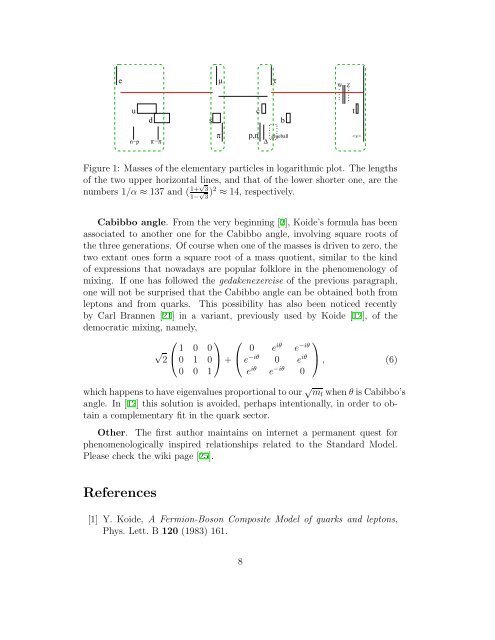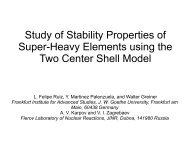The strange formula of Dr. Koide
The strange formula of Dr. Koide
The strange formula of Dr. Koide
Create successful ePaper yourself
Turn your PDF publications into a flip-book with our unique Google optimized e-Paper software.
e<br />
µ<br />
τ<br />
W Z<br />
u<br />
c<br />
d s b<br />
t<br />
n−p<br />
π−π<br />
π<br />
p,n ∆<br />
glueball<br />
<br />
Figure 1: Masses <strong>of</strong> the elementary particles in logarithmic plot. <strong>The</strong> lengths<br />
<strong>of</strong> the two upper horizontal lines, and that <strong>of</strong> the lower shorter one, are the<br />
numbers 1/α ≈ 137 and ( 1+√ 3<br />
1− √ 3 )2 ≈ 14, respectively.<br />
Cabibbo angle. From the very beginning [2], <strong>Koide</strong>’s <strong>formula</strong> has been<br />
associated to another one for the Cabibbo angle, involving square roots <strong>of</strong><br />
the three generations. Of course when one <strong>of</strong> the masses is driven to zero, the<br />
two extant ones form a square root <strong>of</strong> a mass quotient, similar to the kind<br />
<strong>of</strong> expressions that nowadays are popular folklore in the phenomenology <strong>of</strong><br />
mixing. If one has followed the gedakenexercise <strong>of</strong> the previous paragraph,<br />
one will not be surprised that the Cabibbo angle can be obtained both from<br />
leptons and from quarks. This possibility has also been noticed recently<br />
by Carl Brannen [21] in a variant, previously used by <strong>Koide</strong> [12], <strong>of</strong> the<br />
democratic mixing, namely,<br />
⎞ ⎛<br />
⎞<br />
1 0 0 0 e iθ e −iθ<br />
⎛<br />
√<br />
2 ⎝<br />
0 1 0<br />
0 0 1<br />
⎠ + ⎝<br />
e −iθ 0 e iθ<br />
e iθ e −iθ 0<br />
⎠ , (6)<br />
which happens to have eigenvalues proportional to our √ m l when θ is Cabibbo’s<br />
angle. In [12] this solution is avoided, perhaps intentionally, in order to obtain<br />
a complementary fit in the quark sector.<br />
Other. <strong>The</strong> first author maintains on internet a permanent quest for<br />
phenomenologically inspired relationships related to the Standard Model.<br />
Please check the wiki page [25].<br />
References<br />
[1] Y. <strong>Koide</strong>, A Fermion-Boson Composite Model <strong>of</strong> quarks and leptons,<br />
Phys. Lett. B 120 (1983) 161.<br />
8



